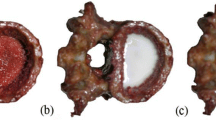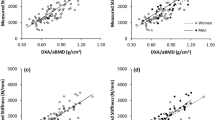Abstract
Introduction
In assessing cervical fractures of the proximal femur, this in vitro quantitative computed tomography (QCT) study had three objectives: to compare QCT to dual-energy X-ray absorptiometry (DXA) for predicting the failure load of the proximal femur, to compare the contributions of density and geometry to bone failure load, and to compare the contributions of cortical and trabecular bone to bone failure load. A novel three-dimensional (3D) analysis tool [medical image analysis framework (MIAF-Femur)] was used to analyze QCT scans.
Methods
The proximal ends of 28 excised femurs were studied (1) using QCT to separately measure bone mineral density (BMD) and geometric variables of trabecular and cortical bone, (2) using mechanical tests to failure in a stance configuration, and (3) using DXA to measure BMD. The variables were described with mean, standard deviation, and range. Correlation matrix and multivariate linear models were computed.
Results
Among correlations, cortical thicknesses of the femoral neck were significantly correlated with femoral failure load, especially of the inferoanterior quadrant (r 2=0.41; p<0.001), as was cortical volume at the “extended neck“ (r 2=0.41; p<0.001). Femoral failure load variance was best explained by a combination of QCT variables. Combining densitometric and geometric variables measured by QCT explained 76% of femoral failure load variance compared with 69% with the DXA model. Geometric variables (measured by QCT) explained 43% of femoral failure load variance compared with 72% for densitometric variables (measured by QCT). A model including only trabecular variables explained 52% of femoral failure load variance compared with 59% for a model including only cortical variables.
Conclusion
The QCT-MIAF reported here provides analysis of both geometric and densitometric variables characterizing cortical and trabecular bone. Confirmation of our results in an independent sample would suggest that QCT may better explain failure load variance for cervical fracture than the gold standard DXA-provided BMD.


Similar content being viewed by others
References
Cooper C, Campion G, Melton LJI (1992) Hip fractures in the elderly: a world-wide projection. Osteoporos Int 2:285–289
Cummings SR, Nevitt MC, Browner WS, Stone K, Fox KM, Ensrud KE, Cauley J, Black D, Vogt TM, Group SoOFR (1995) Risk factors for hip fracture in white women. New Engl J Med 332:767–773
Lotz JC, Cheal EJ, Hayes WC (1995) Stress distributions within the proximal femur during gait and falls: implications for osteoporotic fractures. Osteoporos Int 5(4):252–261
Augat P, Reeb H, Claes LE (1996) Prediction of fracture load at different skeletal sites by geometric properties of the cortical shell. J Bone Miner Res 11:1356–1363
Cody DD, Gross GJ, Hou FJ, Spencer HJ, Goldstein SA, Fyhrie DP (1999) Femoral strength is better predicted by finite element models than QCT and DXA. J Biomech 32:1013–1020
Bergot C, Laval-Jeantet AM, Hutchinson K, Dautraix I, Caulin F, Genant HK (2001) A comparison of spinal quantitative computed tomography with dual X ray absorptiometry in European women with vertebral and non-vertebral fractures. Calcif Tissue Int 68:74–82
Grampp S, Lang P, Jergas M, Glüer CC, Mathur A, Engelke K, Genant HK (1995) Assessment of the skeletal status by peripheral quantitative computed tomography of the forearm: short-term precision in vivo and comparison to dual X-ray absorptiometry. J Bone Miner Res 10:1566–1576
Heuck AF, Block J, Glüer CC, Steiger P, Genant HK (1989) Mild versus definite osteoporosis: a comparison of bone densitometry techniques using different statistical models. J Bone Miner Res 4:891–900
Yu W, Glüer CC, Grampp S, Jergas M, Fuerst T, Wu CY, Lu Y, Fan B, Genant HK (1995) Spinal bone mineral assessment in postmenopausal women: a comparison between dual X-ray absorptiometry and quantitative computed tomography. Osteoporos Int 5:433–439
Genant HK, Engelke K, Fuerst T, Glüer CC, Grampp S, Harris ST, Jergas M, Lang TF, Lu Y, Majumdar S, Mathur A, Takada M (1996) Noninvasive assessment of bone mineral and structure: state of the art. J Bone Miner Res 11:707–730
Kuiper JW, Van Kuijk C, Grashuis JL (1997) Distribution of trabecular and cortical bone related to geometry. A quantitative computed tomography study of the femoral neck. Invest Radiol 32:83–89
Lang TF, Keyak JH, Heitz MW, Augat P, Lu Y, Mathur A, Genant HK (1997) Volumetric quantitative computed tomography of the proximal femur: precision and relation to bone strength. Bone 21:101–108
Lang TF, Guglielmi G, Van Huijk C, De Serio A, Cammisa M, Genant HK (2002) Measurement of bone mineral density at the spine and proximal femur by volumetric quantitative computed tomography and dual-energy X-ray absorptiometry in elderly women with and without vertebral fractures. Bone 30:247–250
Kang Y, Engelke K, Kalender WA (2003) A new accurate and precise 3-D segmentation method for skeletal structures in volumetric CT data. IEEE Trans med Imaging 22:586–598
Kang Y, Engelke K, Kalender WA (2004) Interactive 3D editing tools for image segmentation. Med Image Anal 8:35–46
Kang Y (2002) 3D quantitative computed tomograpy (QCT) of the proximal femur. Institute für Medizinische Physik. Friedrich-Alexander-Universität, Erlangen-Nürnberg
Engelke K, Kang Y, Bousson V, Laredo JD, Kalender WA (2001) A semi-automatic volumetric segmentation of bone applied to spiral CT of the proximal femur to precisely assess density, geometry, and cortical thickness Radiological Society of North America. 87th Scientific Assembly and Annual Meeting., Chicago, IL
Kang Y, Engelke K, Fuchs C, Kalender WA (2005) An anatomic coordinate system of the femoral neck for highly reproducible BMD measurements using 3D QCT. Comput Med Imaging Graph 29:533–541
Faulkner KG, Cummings SR, Black D, Palermo L, Glüer CC, Genant HK (1993) Simple measurement of femoral geometry predicts hip fracture. J Bone Miner Res 8:1211–1217
Mazess RB (1990) Fracture risk: a role for compact bone. Calcif Tissue Int 47:191–193
Cheng XG, Lowet G, Boonen S, Nicholson PHF, Brys P, Nijs J, Dequeker J (1997) Assessment of the strength of proximal femur in vitro: relationship to femoral bone mineral density and femoral geometry. Bone 20:213–218
Bergot C, Bousson V, Meunier A, Laval-Jeantet M, Laredo J-D (2002) Hip fracture risk and proximal femur geometry from DXA scans. Osteoporos Int 13:542–550
Duboeuf F, Hans D, Schott AM, Kotzki PO, Favier F, Marcelli C, Meunier PJ, Delmas PD (1997) Different morphometric and densitometric parameters predict cervical and trochanteric hip fracture: the EPIDOS study. J Bone Miner Res 12:1895–1902
Boyce TM, Bloebaum RD (1993) Cortical aging differences and fracture implications for the human femoral neck. Bone 14:769–778
Bell KL, Loveridge N, Power J, Garrahan N, Stanton M, Lunt M, Meggitt BF, Reeve J (1999) Structure of the femoral neck in hip fracture: Cortical bone loss in the inferoanterior to superoposterior axis. J Bone Miner Res 14:111–119
Crabtree N, Loveridge N, Parker M, Rushton N, Power J, Bell KL, Reeve J (2001) Intracapsular hip fracture and the region specific loss of cortical bone: analysis by peripheral quantitative computed tomography. J Bone Miner Res 7:1318–1328
Martens M, Van Audekercke R, Delport P, De Meester P, Mulier JC (1983) The mechanical characteristics of cancellous bone at the upper femoral region. J Biomech 16:971–983
Werner C, Iversen BF, Therkildsen MH (1988) Contribution of the trabecular component to mechanical strength and bone mineral content of the femoral neck. An experimental study on cadaver bones. Scand J Clin Lab Invest 48:457–460
Lotz JC, Cheal EJ, Hayes WC (1991) Fracture prediction for the proximal femur using finite element models: Part II–Nonlinear analysis. J Biomech Eng 113:361–365
Marks R, Allegrante JP, Ronald MacKenzie C, Lane JM (2003) Hip fractures among the elderly: causes, consequences and control. Ageing Research Reviews 2:57–93
Keyak JH (2000) Relationships between femoral fracture loads for two load configurations. J Biomech 33:499–502
Keyak JH, Kaneko TS, Tehranzadeh J, Skinner HB (2005) Predicting proximal femoral strength using structural engineering models. Clin Orthop 437:219–228
Hangartner TN, Gilsanz V (1996) Evaluation of cortical bone by computed tomography. J Bone Miner Res 11:1518–1525
Newman DL, Dougherty G, Al Obaid A, Al Hajrasy H (1998) Limitations of clinical CT in assessing cortical thickness and density. Phys Med Biol 43:619–626
Prevrhal S, Engelke K, Kalender WA (1999) Accuracy limits for the determination of cortical width and density: the influence of object size and CT imaging parameters. Phys Med Biol 44:751–764
Bousson V, Bergot C, Meunier A, Barbot F, Parlier-Cuau C, Laval-Jeantet AM, Laredo J-D (2000) CT of the middiaphyseal femur: cortical bone mineral density and relation to porosity. Radiology 217:179–187
Acknowledgements
We thank Professor Jean-Pierre Lassau, director of the Saint-Pères (Paris VI) Pathology Laboratory, where the femurs were harvested. This work was supported in part by EU grants (contract number QLK6-CT-2002-02440-3DQCT).
Author information
Authors and Affiliations
Corresponding author
Additional information
This work was supported in part by grants from EU, contract number: QLK6-CT-2002-02440-3DQCT
Rights and permissions
About this article
Cite this article
Bousson, V., Le Le Bras, A., Roqueplan, F. et al. Volumetric quantitative computed tomography of the proximal femur: relationships linking geometric and densitometric variables to bone strength. Role for compact bone. Osteoporos Int 17, 855–864 (2006). https://doi.org/10.1007/s00198-006-0074-5
Received:
Accepted:
Published:
Issue Date:
DOI: https://doi.org/10.1007/s00198-006-0074-5




